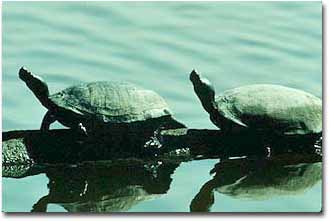
Predominantly forest, the 400 acre Wellington WMA is located in eastern Somerset County. Wellington WMA is part of one of the largest forested tracts found on Maryland's Eastern Shore. Wellington WMA is also the location of the Wildlife and Heritage Service Field Office for Wicomico, Somerset, and Worcester Counties.
What To See
The extensive forests at Wellington attract forest wildlife including woodcock, hairy and downy woodpeckers, and many species of warblers. Wellington's forests provide critical nesting areas for songbirds which migrate from Central and South America. Many of these are vibrantly colored, like the scarlet tanager and yellow-throated vireo. Fields which dot the forest landscape attract bobwhite quail, weasel, white-tailed deer and cottontail rabbits. Wild turkeys, which disappeared from Maryland's Eastern Shore in the 19th Century, have been reintroduced at Wellington. Turkey populations have grown at Wellington and small flocks can be seen searching for insects in the grassy fields. The wet fields and forest areas support mink, as well as frogs and turtles. In the spring, spring peepers, green tree frogs and wood frogs join in a chorus which rings throughout the area.
What To Do
Hunters will find excellent opportunities to bag white-tailed deer, turkeys, gray squirrels, woodcock, bobwhite quail and cottontail rabbits. Unmarked trails invite those who enjoy a challenging hike or an all-terrain bicycle ride. The many colorful songbirds and other wildlife, as well as wildflowers and butterflies make a rewarding day for the nature photographer.
Area Regulations
- Use of Wellington WMA is generally permitted seven days a week throughout the year.
- Hunting is allowed in accordance with open seasons and shooting hours, unless otherwise noted.
- All State and Federal Hunting Laws and Regulations are applicable.
- Trapping is by permit only.
- Dove hunting is restricted to certain days and shooting hours.
- No motorized vehicles are allowed.
Non-hunting Users Guide
- Non-hunting visitors are welcome.
- Be aware of open hunting seasons and visit accordingly.
- Season dates available in newspapers, on the Internet, and at some area stores.
- Trails are maintained and suitable for hiking, nature photography, birding, hunting and other recreational activities, but are not actively marked.
- A large percentage of Wellington is wetland and during the winter and spring months boots are recommended.
- Visitors to the management area should be aware that there may be biting flies, mosquitoes, and ticks present during April – November.
Site Management Goals
- The agricultural fields are planted with crops to provide habitat and winter food for upland wildlife species.
- Several small ponds have been created and are managed to provide habitat for waterfowl, aquatic mammals, and amphibians.
- Certain fields are managed dove hunting areas.
- Some fields have been planted to native warm season grasses, cool season grasses and/or been left fallow to provide habitat for ground nesting wildlife species.
 Directions
Directions
Wellington WMA is located in eastern Somerset County on Dublin Road. From U.S. Route 13 ,take King Miller Road east to Old Princess Anne-Westover Road, south to Dublin Road and Wellington WMA. For additional information, contact the Wellington Wildlife Office at (410) 651-2065.
 Click Here for Map
Click Here for Map
This area is a part of Maryland’s Department of Natural Resources public land system and is managed by the Wildlife and Heritage Service. The primary mission of the WMA system is to conserve and enhance wildlife populations and their respective habitats as well as to provide public recreational use of the State’s wildlife resources.
Eighty-five percent of the funding for Maryland's state wildlife programs comes from hunting license fees and a federal excise tax on sport hunting devices and ammunition. The federal aid funds are derived from the Federal Aid in Wildlife Restoration (or Pittman-Robertson) Fund, which sportsmen and women have been contributing to since 1937. Each state receives a share of the funds, which is administered by the U. S. Fish and Wildlife Service; these funds are used for wildlife conservation and hunter education programs, including the management of the WMA system.
Other sources of funds for land acquisition include Program Open Space Funding for Maryland's State and local parks and conservation areas, provided through The Department of Natural Resources' Program Open Space. Established in 1969, Program Open Space symbolizes Maryland's long-term commitment to conserving natural resources while providing exceptional outdoor recreation opportunities.